Drs. Vishal Parashar, Rupali Balpande, Amil Sharma, Snehal Markandey, Neetish Shriram Chavhan, and Gayatri Deshmukh surveyed 161 dentists on whether space closure should be done orthodontically or restoratively.
Drs. Vishal Parashar, Rupali Balpande, Amil Sharma, Snehal Markandey, Neetish Shriram Chavhan, and Gayatri Deshmukh survey doctors about their preferred course of treatment
Abstract
Introduction
Spacing is a main concern that can hamper the patient’s esthetics. Space closure, whether in the anterior or the posterior region, is a major concern. Spacing in the anterior region might affect the self-esteem of the patient, and spacing in the posterior region might hamper the function and become traumatic, ultimately damaging the gingiva and the oral structures.
Aims and objectives
To compare and evaluate the perspective of the general dentist to treat space closure — orthodontic, restorative, or prosthetic.
Materials and methods
Two patient images — case No. 1 and case No. 2 (one male and one female) — with different types of spacing were provided to a set of 30 general dentists to evaluate the type of modality that they would prefer to use for the closure of the spaces.
Statistical analysis and results
A total of 161 general dentists participated in this survey. These general dentists’ experience in practicing dentistry ranged from 1 to 26 years.
Discussion
The results for case No. 1 have shown that majority of the dentists believed that the space closure could be performed using the orthodontic method, which accounted for around 57.14% of the responses. The results for case No. 2 have shown that the majority of the dentists believed that space closure can be performed using a restorative procedure, which accounted for about 49.68% of the responses.
Conclusion
The research study concluded that the majority of general dentists would opt for the orthodontic method of space closure when the spacing is more generalized. For very minor spacing or a midline diastema, general dentists prefer restoration as a method of treatment.
Introduction
Excess space in the dental arch is diagnosed as generalized spacing or a local divergence. This is often observed in the maxillary anterior region as median diastema, traumatic loss of central incisors, or congenital absence of lateral incisors. Spacing in the posterior region of the jaw may be due to congenitally missing tooth/teeth or excessive proclination of the anterior teeth, which causes drifting of the posterior teeth into the available spaces and impaction of adjacent tooth. Interdental spacing in the anterior or the posterior regions of the mouth can present a challenge to the attending clinician for restoring esthetics and function. In such instances, an interdisciplinary approach is necessary to evaluate, diagnose, and resolve esthetics.1 Perception is “the process or result of becoming aware of objects, relationships, and events by means of the senses, which includes such activities as recognizing, observing, and discriminating.2 Once the etiology is known, a decision must then be taken whether to utilize a multidisciplinary approach or to simply close the spaces by means of direct and/or indirect restorative treatment.3
Aims and objectives
To compare and evaluate the perception of the general dentist to determine how space closure can be treated — orthodontically, restoratively, or prosthetically.
Materials and methods
In this era of modernization and technology, communication has taken a fast-forward step through the availability of various communications methods, including social media like WhatsApp, Facebook, and Twitter, among others. Other methods include various search engines — e.g., Google, Bing, Wiki.com, and other mass media devices such as computers, cellphones, and tablets. A questionnaire was created using the Google form (Figure 1).
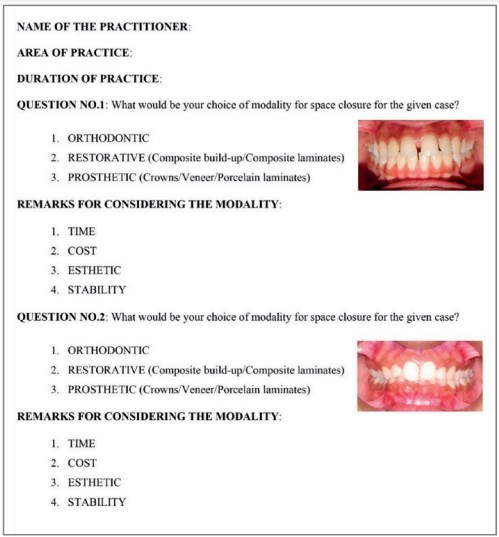
This form consisted of intraoral frontal photographs of two patients (Figures 2 and 3). One patient consisted of generalized spacing, and the other patient consisted of a midline spacing.
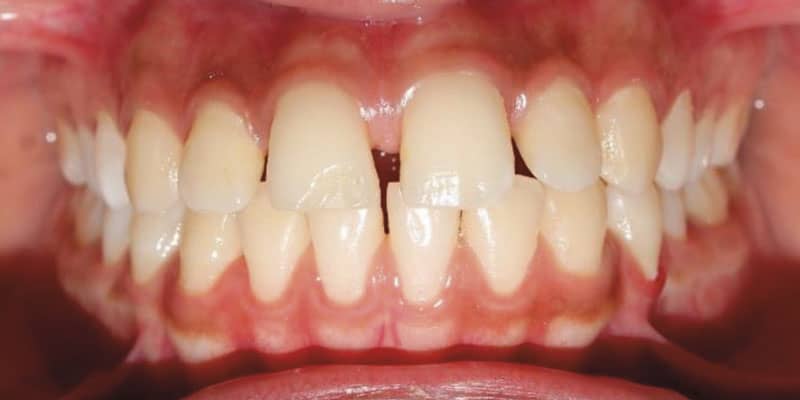
This form was circulated among general dentists across the state of Maharashtra, India, using mass media and social media applications — e.g., WhatsApp, Facebook Messenger, and general SMS. The dentists were provided with the questions, which included their choice of treatment modality for space closure, and were asked to mention the reason for selecting the specific treatment.
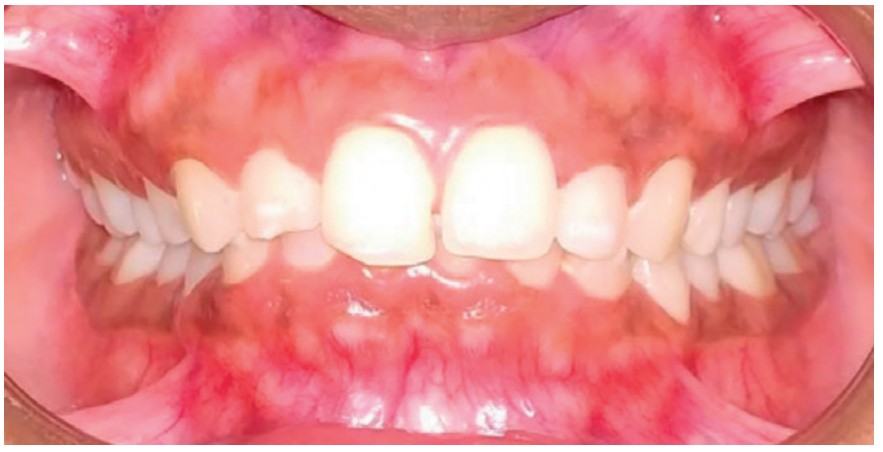
Statistical analysis and results
A total of 161 general dentists participated in this survey type of research study. Their experience in practicing dentistry ranged from 1 to 26 years; they belonged to various locations throughout Maharashtra, India. A comparative study was done for the received values from the various general dentists represented by a simple bar graph for the maximum and the minimum responses obtained.
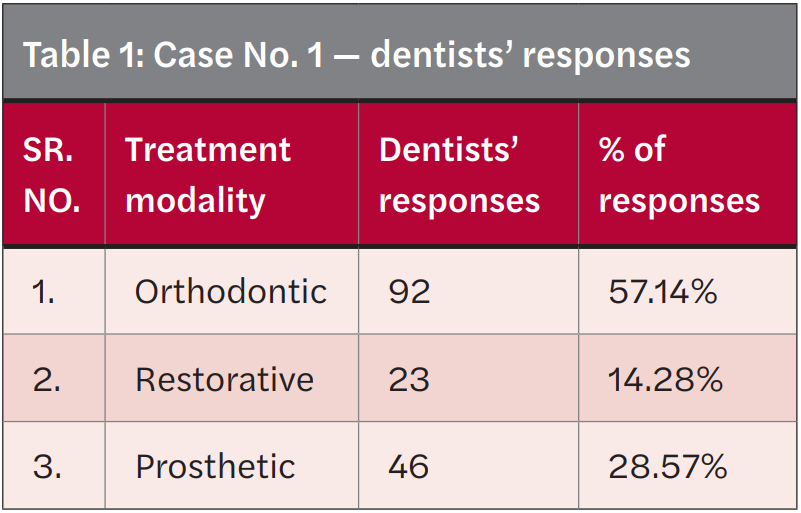
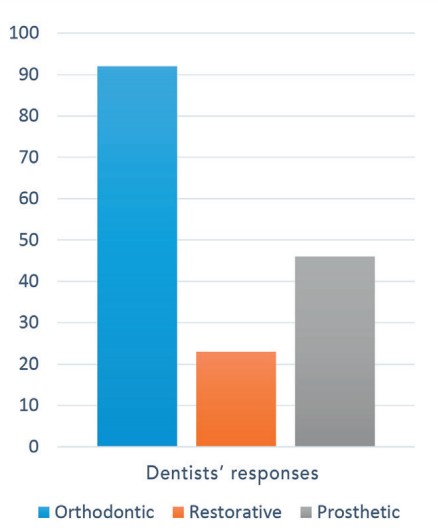
For case No. 1 (Figure 2), which included the preference of the treatment modality to be used for the closure of the space, the majority answered with preference for the Orthodontic (Table 1 and Table 2) modality. For the same question, the reason for the selection of a particular modality indicated that most of the general dentists reasoned Esthetics (Table 3 and Table 4) and Stability (Table 3 and Table 4) to be the major criteria.
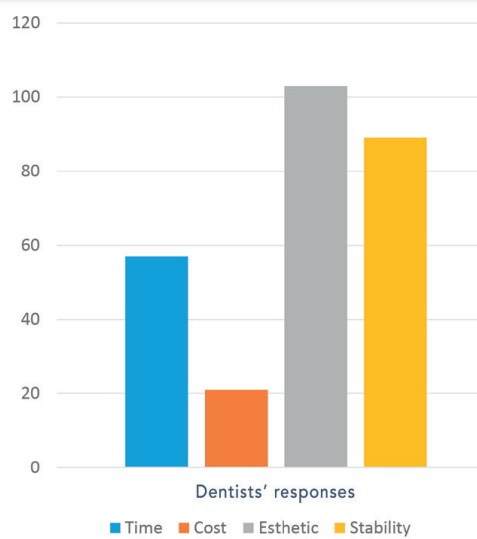
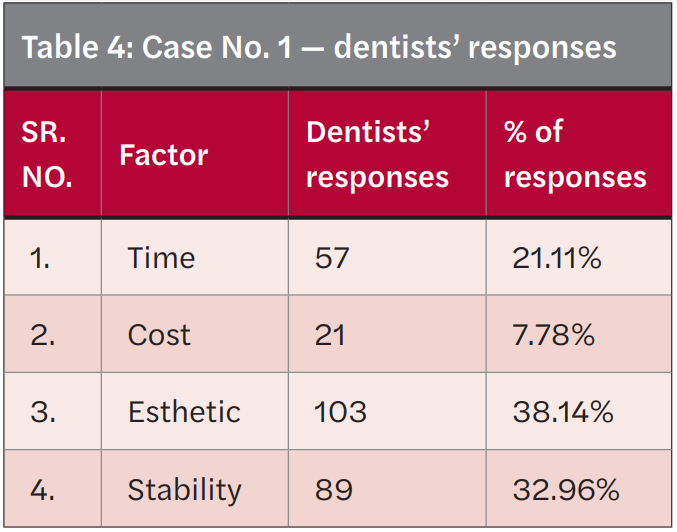
Similarly, for the next patient — case No. 2 (Figure 3) — the majority of the general dentists suggested that the patient would benefit from Restorative (Table 5 and Table 6) treatment. The reason for this modality selection was Esthetics and Time (Table 8).
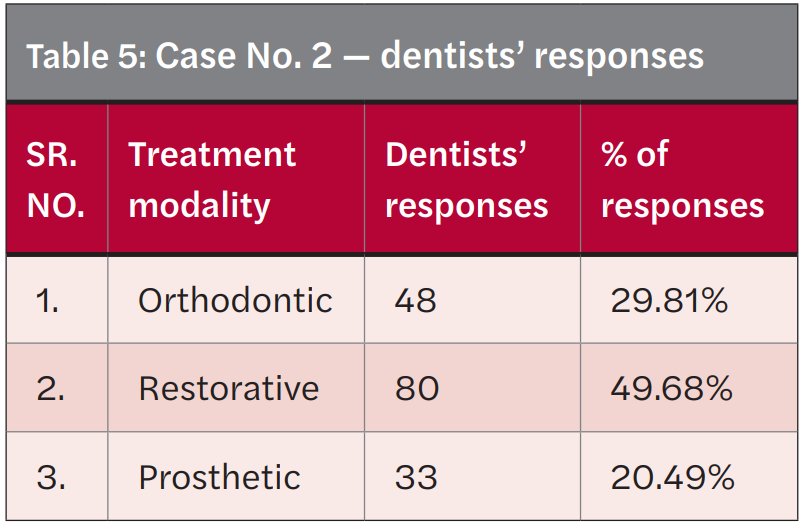
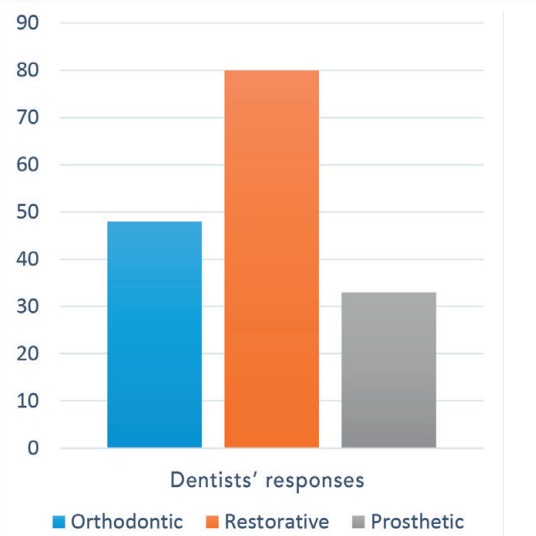
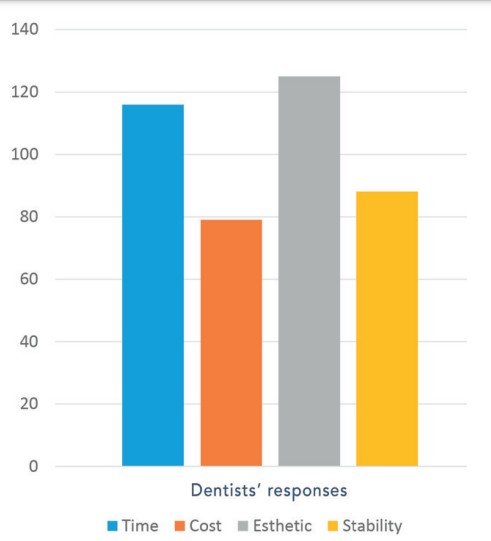

Discussion
The results for case No. 1 have shown that majority of the dentists believed that the space closure could be performed using the orthodontic mean, which accounted for around 57.14% of the response. The reason of selection of this mode was esthetics and stability, which accounted for 38.14% and 32.96%, respectively. The results for case No. 2 have shown that majority of the dentists believed that space closure could be performed using the restorative procedure, which accounted for about 49.68% of the responses. The reason that the majority of clinicians voted for the selection of this technique was Esthetics, which accounted for 30.63% of responses, and for time, which accounted for 21.56% of the responses. A review of the past literature noted a difference of opinion among the group of people selected, whether it be students, dental professionals, or laypeople. Differences in responses to viewing a particular case created a wide variety of opinions for the same case. Ribeiro, et al., (2004) performed a study with the help of a questionnaire format to understand the perceptions of 20 dentists, 20 dental students, and 20 laypeople about the use of sedatives in a dental environment.4 The study concluded that only a few participants in any of the three categories felt confident about the topic. The group consisting of laypeople were optimistic, while dentists and students showed insufficient exposure to the subject at school.
Mota and Pinho (2015) performed a study to understand the perception toward a smile in maxillary lateral incisor agenesis (MLIA) cases treated by protracting a canine.5 The most attractive results for MLIA treatment showed that unilateral dental and gingival reshaping was most significant. The subjects in all of the groups felt that simple reshaping of the tooth structure was more than sufficient for Esthetics. When the images of the unilateral and bilateral MLIA were analyzed together, the study found that dental and gingival reshaping was more attractive than the unmodified one. The Taibah study (2018) explored dental patients’ perception toward dental professionalism and then compared their views to dental professionals’ views.6 Patients’ and dentists’ views toward dental professionalism and professional behavior was found to vary in certain aspects. These differences in the opinion must be addressed and understood to provide for better dental treatment in the future.
The Rosa, et al., (2013) study sought to understand the difference in opinions among various subjects on the images of the patients’ altered smiles due to missing maxillary lateral incisors with or without treatment.7 An interdisciplinary approach, combining restorative treatment along with orthodontic treatment, has also been mentioned in the literature as a procedure for space closure.8 The literature shows case reports whereby space closure was indicated by orthodontic treatment, which was actually done using restorative treatment.3 Subjects voted for space closure with orthodontic treatment as the most attractive smile, and the similar cases received a higher response by dental professionals as compared to the patients and laypeople. Treatment, absence of diastema, and symmetry were the most accepted characteristics by all categories of respondents. Extensive literature is available that discusses the perception concept and the ways to treat it according to various departments — including prosthetic, cosmetic, and orthodontic closure of spaces. This literature indicates that perception of space closure is a multidisciplinary approach.9-20
Conclusion
General dentists showed a different perception for space closure, whether it be in the anterior or the posterior region of the oral cavity. The majority of the general dentists opted for orthodontics as a method of space closure when the spacing is more generalized. For very minor spacing or a midline diastema, general dentists preferred selecting restoration as a method of treatment. From the research study presented here, major spacing, esthetics, and stability are the deciding factors; however, for minor spacing, esthetics and time are the major factors. Ultimately, any treatment is the dentists’ decision after taking into consideration the patients’ requirements and needs.
In this article, Drs. Amy H. Hoch, Gerald Hoch, Analia Veitz-Keenan, Olivier Nicolay, and George J. Cisneros discuss why clinicians choose one technique for space closure over another. https://orthopracticeus.com/ce-articles/two-step-retraction-versus-en-masse-retraction-maxillary-space-closure/
- Park JH, Tai K, Kanao A, Takagi M. Space closure in the maxillary posterior area through the maxillary sinus. Am J Orthod Dentofacial Orthop. 2014 ;145(1):95-102.
- APA Dictionary of Psychology: “Perception.” https://dictionary.apa.org/perception. Accessed January 13, 2022.
- Goyal A, Nikhil V, Singh R. Diastema closure in anterior teeth using a posterior matrix. Case Rep Dent. Published online October 13, 2016. doi: 10.1155/2016/2538526. Accessed January 13, 2022.
- Costa LR, Dias AD, Pinheiro LS, et al. Perceptions of dentists, dentistry undergraduate students, and the lay public about dental sedation. J Appl Oral Sci. 2004;12(3):182-188.
- Mota A, Pinho T. Esthetic perception of maxillary lateral incisor agenesis treatment by canine mesialization. Int Orthod. 2016;14(1):95-107.
- Taibah SM. Dental professionalism and influencing factors: patients’ perception. Patient Prefer Adherence. 2018;12:1649-1658.
- Rosa M, Olimpo A, Fastuca R, Caprioglio A. Perceptions of dental professionals and laypeople to altered dental esthetics in cases with congenitally missing maxillary lateral incisors. Prog Orthod. 2013;14:34.
- Hwang SK, Ha JH, Jin MU, Kim SK, Kim YK. Diastema closure using direct bonding restorations combined with orthodontic treatment: a case report. Restor Dent Endod. 2012;37(3):165-169.
- Proffit WR, Fields HW Jr, Sarver DM. Contemporary Orthodontics. 4th ed. Mosby; 2007.
- Misch CE. Contemporary Implant Dentistry. 2nd ed. Mosby; 1999.
- Van der Geld P, Oosterveld P, Van Heck G, Kuijpers-Jagtman AM. Smile attractiveness: self-perception and influence on personality. Angle Orthod. 2007;77(5):759-765.
- Klages U, Zentner A. Dentofacial aesthetics and quality of life. Semin Orthod. 2007;13(2):104-115.
- Miller CJ. The smile line as a guide to anterior esthetics. Dent Clin North Am. 1989;33(2): 157-164.
- Thomas M, Reddy R, Reddy BJ. Perception differences of altered dental esthetics by dental professionals and laypersons. Indian J Dent Res. 2011;22(2):242–247.
- Mokhtar HA, Abuljadayel LW, Al-Ali RM, Yousef M. The perception of smile attractiveness among Saudi population. Clin Cosmet Investig Dent. 2015;7:17-23.
- Abu Alhaija ES, Al-Shamsi NO, Al-Khateeb S. Perceptions of Jordanian laypersons and dental professionals to altered smile aesthetics. Eur J Orthod. 2011;33(4):450-456.
- Mehl C, Wolfart S, Vollrath O, Wenz HJ, Kern M. Perception of dental esthetics in different cultures. Int J Prosthodont. 2014;27(6):523-529.
- Isiksal E, Hazar S, Akyalçin S. Smile esthetics: perception and comparison of treated and untreated smiles. Am J Orthod Dentofacial Orthop. 2006;129(1):8-16.
- Oesterle LJ. Shellhart WC. Maxillary midline diastemas: a look at the causes. J Am Dent Assoc. 1999;130(1):85-94.
- Romero MF, Babb CS, Brenes C, Haddock FJ. A multidisciplinary approach to the management of a maxillary midline diastema: A clinical report. J Prosthet Dent. 119(4):502-505.
Stay Relevant With Orthodontic Practice US
Join our email list for CE courses and webinars, articles and mores


